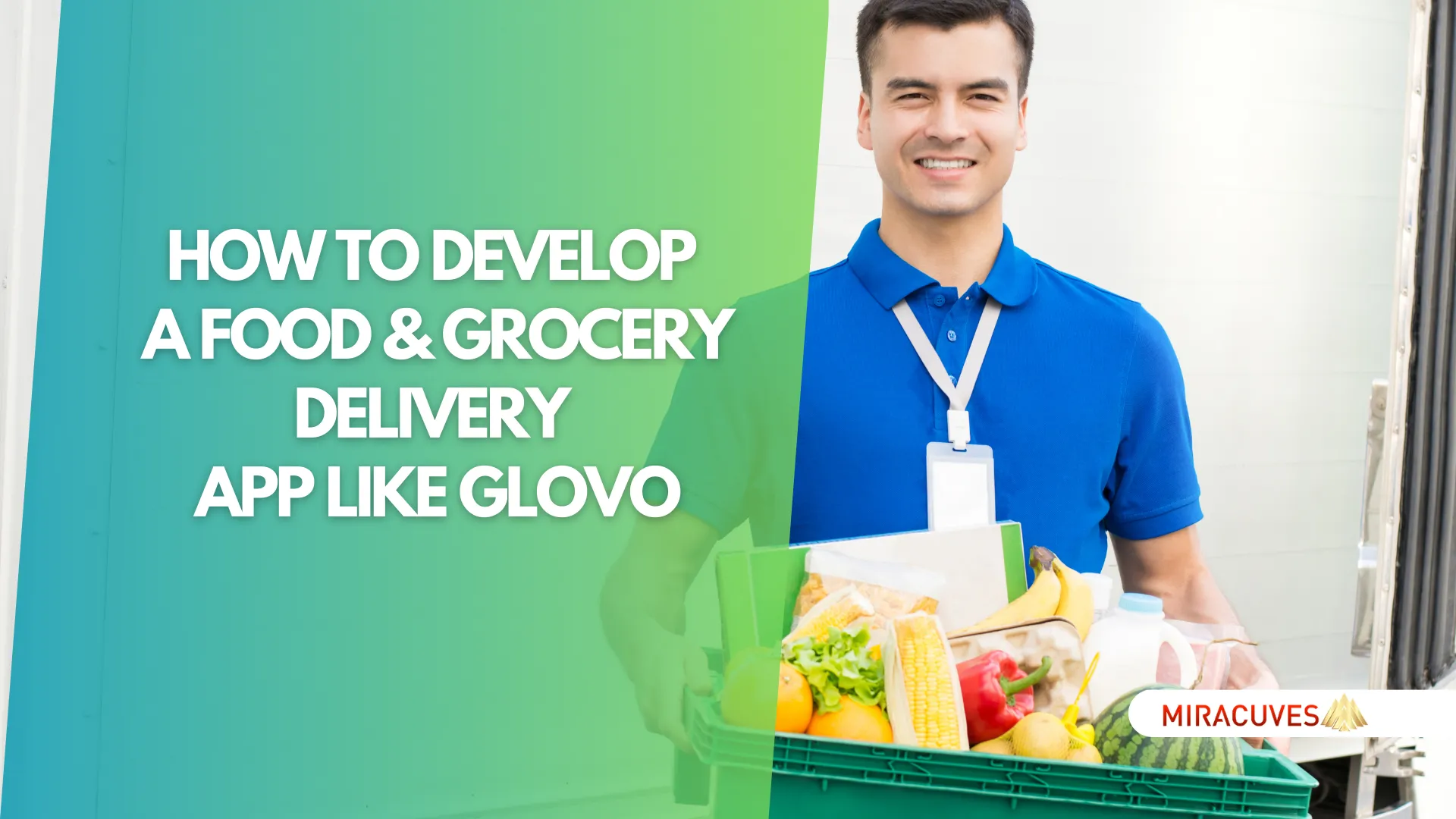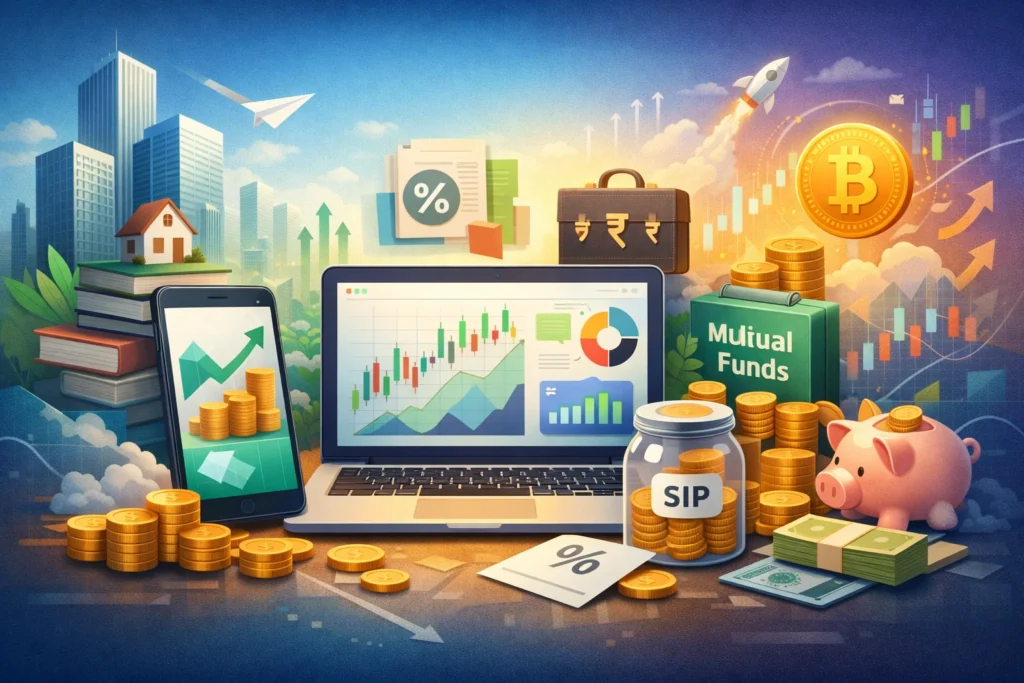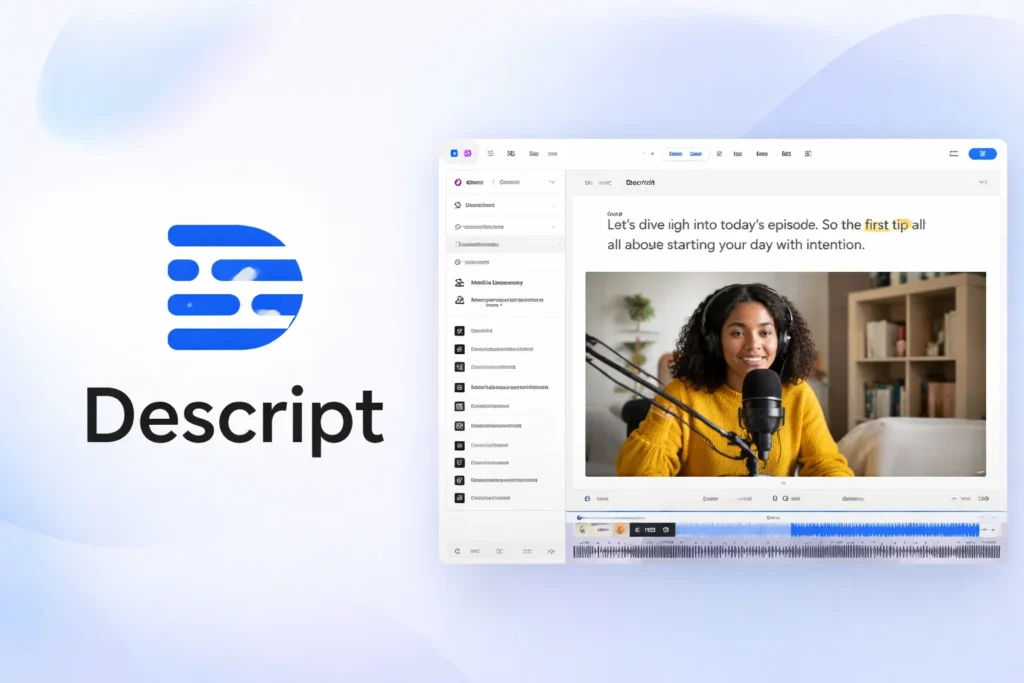In today’s fast-paced world, the demand for quick and reliable delivery services has skyrocketed. Apps like Glovo have become essential for millions of users who need everything from food to groceries and even parcel deliveries at their fingertips. As more consumers turn to on-demand delivery solutions, building an app like Glovo offers incredible opportunities for businesses and entrepreneurs to tap into this thriving industry. Whether you’re a startup looking to disrupt the market or an established business wanting to expand, developing a Glovo-like app can be a highly profitable venture.
This guide will take you through every step of the process to help you understand what it takes to build a successful delivery app like Glovo. We’ll cover the essential features, technical requirements, development costs, and timelines, giving you a clear picture of what’s needed to create an app that can compete in this growing market. With the right strategy, innovative features, and the backing of an experienced development partner like Miracuves Solutions, you can build an app that stands out and meets the needs of modern consumers.
What is Glovo and What Does It Do?
Glovo is a versatile on-demand delivery app that enables users to order almost anything, from food and groceries to pharmacy items and packages, directly to their doorstep. Launched in 2015, the app has grown rapidly and now operates in numerous cities worldwide, making it one of the leading multi-service delivery platforms.
What sets Glovo apart from other delivery apps is its broad range of services. Users can order not only meals from restaurants but also products from local stores, pharmacies, and even personal errands. The app connects users with couriers, who pick up and deliver the requested items quickly and efficiently. This multi-functional approach has made Glovo a go-to solution for customers looking for convenience and speed.
In addition to catering to individual users, Glovo also supports local businesses by providing them with a platform to reach more customers and expand their sales through delivery services. Whether it’s a restaurant delivering food or a grocery store fulfilling household needs, Glovo acts as a digital marketplace that connects customers with a vast array of local suppliers.
The success of Glovo lies in its ability to offer a seamless user experience, from placing an order to tracking it in real time. By providing multiple services in one app, Glovo appeals to a diverse audience, creating a high-demand platform for both users and businesses.
Why Build an App Like Glovo?
Building an app like Glovo presents a massive business opportunity, particularly in the evolving world of on-demand delivery. The rise of convenience culture has created a booming market for apps that can deliver a wide range of products, from food to groceries, straight to the consumer’s door. Glovo’s success shows how demand for such services is only growing, making it an ideal time to enter the market with a similar app.
One of the main reasons to build an app like Glovo is its profitability and scalability. The on-demand delivery market is expanding globally, with millions of users relying on these services for daily needs. By offering a platform where users can order not just food but also groceries, medicine, and even send packages, you open up multiple revenue streams. Delivery fees, service commissions, and partnerships with local businesses can all contribute to a sustainable business model.
Another benefit is the flexibility and adaptability of such a platform. A multi-service app allows businesses to diversify their offerings and cater to different market segments. For instance, during high demand for food delivery, restaurants will be your main partners, but at other times, you may see a surge in grocery or pharmacy orders. This adaptability is key to maintaining steady growth.
Moreover, as digital transformation continues across industries, customers expect instant access and convenience. An app like Glovo meets those needs, offering consumers a quick, efficient solution to get what they need, whenever they need it. For businesses, developing such an app not only boosts visibility but also strengthens relationships with customers who prefer the convenience of mobile-first services.
How to Differentiate Your App from Competitors
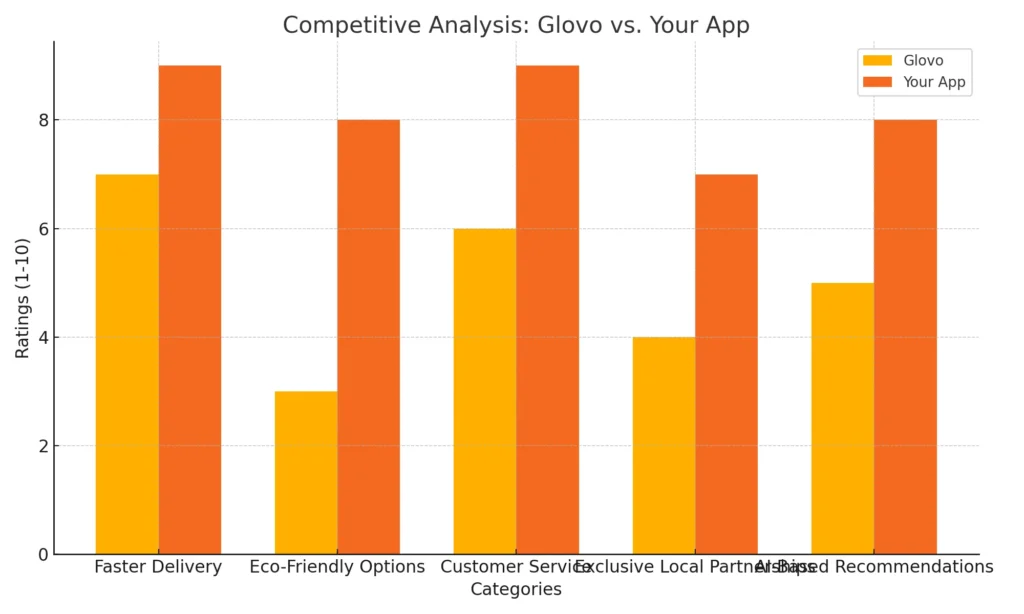
In a competitive market where apps like Glovo, UberEats, and DoorDash dominate, standing out is essential for success. To ensure your app doesn’t just blend in with the crowd, it’s crucial to identify and implement unique features and targeted strategies that can make your app appealing to both users and businesses.
One way to differentiate your app is by focusing on a niche market. For example, while Glovo offers a wide range of services, you could focus on specific areas such as eco-friendly deliveries, prioritizing sustainable packaging and transportation methods like electric bikes or scooters. This appeals to environmentally conscious consumers who are increasingly seeking sustainable options in their daily lives.
Another key differentiator can be in offering superior customer service and faster delivery times. While this may sound simple, improving user experience by reducing delivery times and resolving customer complaints quickly can have a massive impact. Offering features like real-time courier communication or delivery time guarantees can also give your app an edge.
Furthermore, consider integrating advanced technology like AI-based recommendations, personalized offers, or loyalty programs. These features can keep users engaged by offering a customized experience that adjusts based on their preferences and habits. For businesses, offering in-depth analytics and insights into customer behavior will make your app an attractive partner for local stores and restaurants.
Additionally, building strong local partnerships with niche retailers or service providers that aren’t available on larger platforms like Glovo can help you attract a dedicated customer base. Exclusive deals or partnerships with small businesses can make your app the go-to choice for unique or hard-to-find products.
Also Read :- How to Develop a Food Delivery App Like Zomato: Features, Costs, and Timeline
Market Size, Growth, and Business Model
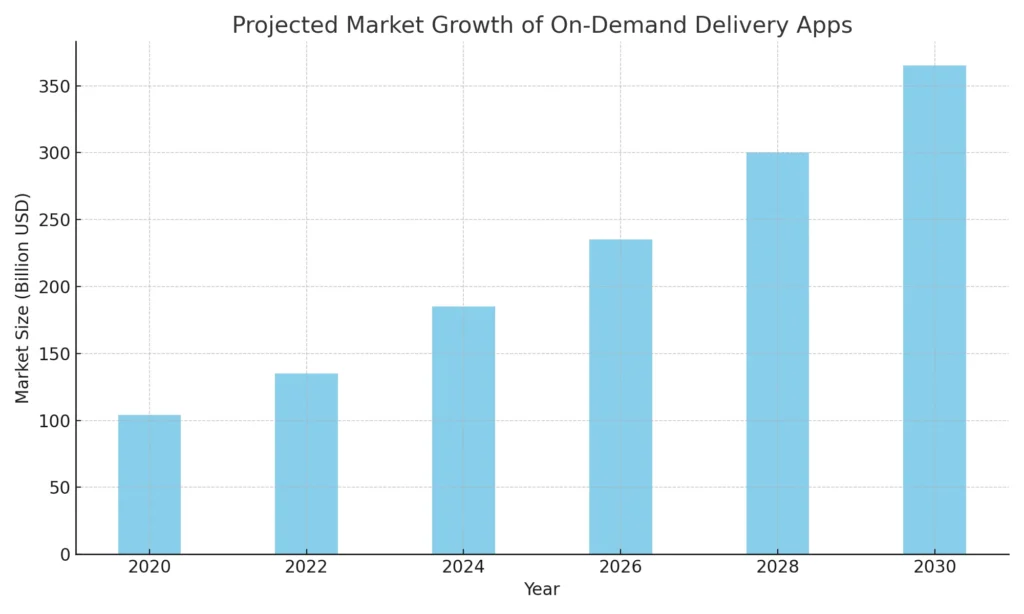
The on-demand delivery market has seen explosive growth over the past few years, and it’s projected to expand even further. According to recent data, the global market for delivery apps, including multi-service platforms like Glovo, is expected to reach $365 billion by 2030, driven by the increasing demand for convenience, speed, and mobile-first services.
Building an app like Glovo puts you in a lucrative position within this expanding industry. Not only can you tap into multiple delivery verticals such as food, groceries, and parcels, but you can also adapt your business to the changing needs of consumers. This flexibility allows for long-term growth and stability in a highly competitive market.
When it comes to the business model of a Glovo-like app, there are several proven ways to generate revenue. The primary source is through delivery fees, which are charged to users based on the distance and order type. You can also earn a commission from partner businesses, typically restaurants and local stores, for each order processed through the app. Another revenue stream is in-app advertising, where businesses can pay for premium visibility within the app, boosting their presence and attracting more customers.
For those looking to expand their offerings, adding a subscription model for users can unlock premium features like reduced delivery fees, priority customer service, and exclusive deals. This can create a steady income stream while improving customer loyalty. By combining these various models, you can ensure that your app remains profitable and scalable as it grows.
Key Features of a Glovo-Like Delivery App
| Feature | Users | Couriers | Businesses |
|---|---|---|---|
| Profile Management | User registration and profiles | Courier profiles with verification | Business dashboard for order management |
| Real-Time Tracking | Track orders from placement to delivery | Route optimization and in-app navigation | N/A |
| Payment Options | Multiple payment methods (credit cards, wallets) | N/A | Payment tracking for orders |
| Order Scheduling | Schedule orders in advance | N/A | N/A |
| Earnings Dashboard | N/A | Earnings and delivery tracking | Sales tracking and analytics |
| Order Management | View and manage past orders | N/A | Manage incoming orders |
| Notifications | Order status updates and promotions | Delivery alerts and route updates | Order alerts and feedback |
| Customer Support | In-app customer support | Support for delivery issues | Support for order issues |
To build a successful delivery app like Glovo, you need to ensure that your platform includes a set of essential features that cater to users, couriers, and businesses. These features not only provide convenience but also create a seamless and efficient experience for all involved parties.
For users, the app should offer:
- User Registration & Profiles: Simple sign-up with options for social media login or email registration. Profiles store user information, preferences, and order history.
- Real-Time Tracking: Users should be able to track their orders from the moment they are placed until delivery, with updates on the courier’s location and estimated delivery time.
- Multiple Payment Options: Flexibility in payment methods, including credit cards, digital wallets, and even cash on delivery, is crucial for user satisfaction.
- Order Scheduling: Allow users to schedule orders in advance, especially for groceries and large items, to enhance convenience.
For couriers, the app should have:
- Courier Profiles: Couriers need personal profiles with verification for identification, past deliveries, and ratings.
- Route Optimization: Integration with mapping services to help couriers find the fastest route, minimizing delivery time and fuel costs.
- In-App Navigation: Built-in navigation tools to assist couriers during deliveries without needing to switch between apps.
- Earnings Dashboard: Couriers should have access to a dashboard where they can track their earnings, delivery count, and tips.
For businesses (restaurants, stores):
- Business Dashboard: A comprehensive dashboard for tracking orders, sales, and customer engagement, giving businesses insight into their performance.
- Order Management System: A simple interface for managing incoming orders, processing them quickly, and communicating with couriers.
- Analytics and Insights: Provide businesses with data on customer behavior, peak order times, and popular products to help optimize their operations.
These core features make up the foundation of a robust delivery app, enabling users, couriers, and businesses to interact efficiently and ensuring smooth operations. Additional features like push notifications, in-app chat, and loyalty programs can further enhance user engagement and retention.
Minimum Viable Product (MVP) Approach
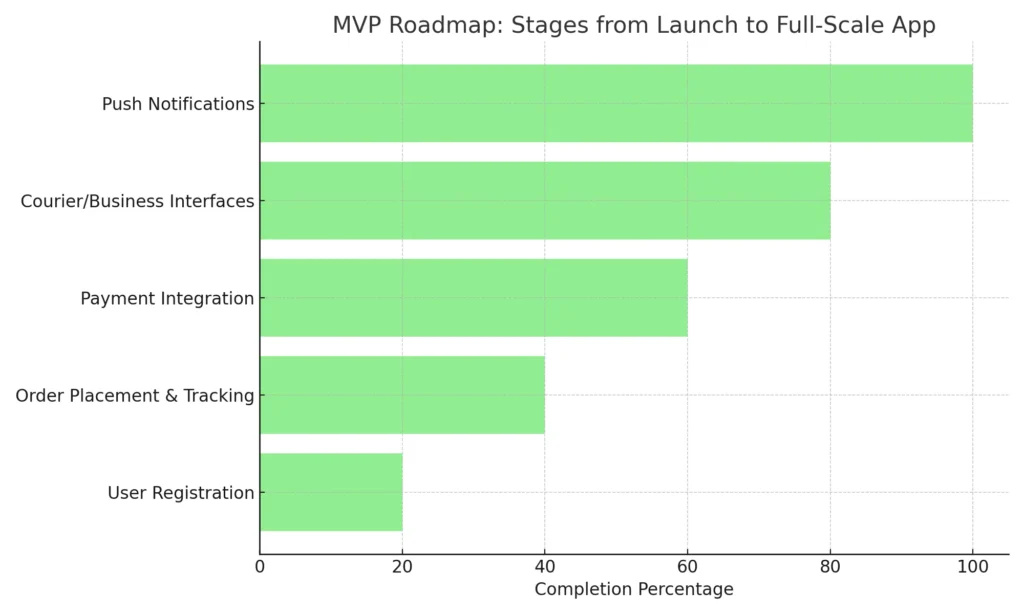
When developing an app like Glovo, starting with a Minimum Viable Product (MVP) is a smart strategy. An MVP allows you to launch a version of the app with just the essential features needed to meet users’ core needs while minimizing initial costs and development time. This approach enables you to gather valuable feedback from users early on and make data-driven improvements to your app over time.
For a Glovo-like app, the MVP should focus on the most critical features that will allow users to order and track deliveries, couriers to manage deliveries efficiently, and businesses to process orders. Here’s what your MVP might include:
- User Registration and Profile Management: Allow users to sign up, create profiles, and store information like delivery addresses and payment methods. This helps in simplifying the order process.
- Order Placement and Tracking: Users should be able to place orders and track them in real time. A simple map integration to show the delivery location and estimated time of arrival is crucial.
- Payment Integration: Secure, multiple payment options such as credit cards, digital wallets, and cash on delivery should be available from the start. Ensuring smooth payment processing is essential for user trust.
- Basic Courier and Business Interfaces: Couriers need to be able to view delivery tasks and navigate to delivery locations, while businesses need a basic order management system to accept and process incoming orders.
- Push Notifications: Simple notifications that inform users about order confirmation, courier assignment, and delivery updates keep them engaged throughout the process.
Launching with these key features will give you a working app that meets users’ immediate needs, allowing you to test the market and validate your idea before investing in more complex functionalities. Over time, you can expand the app by adding features like loyalty programs, advanced analytics for businesses, and AI-based recommendations to improve user experience.
Technical Requirements for Developing a Glovo-Like App
| Category | Technology | Pros | Cons |
|---|---|---|---|
| Frontend | React Native | Cross-platform, reusable codebase, fast development | May require native modules for advanced features |
| Flutter | High-performance, rich UI, cross-platform | Newer framework, fewer third-party libraries | |
| Backend | Node.js | High scalability, handles real-time data well | May struggle with CPU-intensive tasks |
| Python (Django) | Easy to write and maintain, rich libraries | Slower than Node.js for real-time apps | |
| APIs | Google Maps API | Accurate real-time tracking and routing | Usage can be costly at scale |
| Stripe/PayPal | Secure and reliable payment processing | Transaction fees | |
| Database | MongoDB | Scales easily, handles unstructured data | May require additional resources for complex queries |
| MySQL | Excellent for structured data, complex queries | Limited scalability for very large datasets |
To develop a successful Glovo-like delivery app, it’s crucial to choose the right technologies that ensure smooth performance, scalability, and user satisfaction. The technical stack you choose will directly impact the app’s functionality, speed, and ability to handle large volumes of users and orders.
Frontend Technologies:
For the frontend (the part of the app that users interact with), you need a responsive, fast, and mobile-first design. React Native and Flutter are two of the most popular frameworks for building cross-platform mobile apps. These technologies allow you to develop apps for both iOS and Android with a single codebase, significantly reducing development time and cost while maintaining high performance.
Backend Technologies:
The backend of the app is what powers the core functionality, such as order management, user authentication, and communication between users and couriers. Popular choices for backend development include:
- Node.js: Known for its speed and scalability, Node.js is ideal for handling multiple user requests and real-time data transfer.
- Python (Django/Flask): Python is widely used for its simplicity and powerful libraries, making it a good choice for building an app with complex features.
APIs and Third-Party Integrations:
Integrating the right APIs is essential to provide key functionalities like:
- Google Maps API: Enables real-time tracking and efficient route optimization for couriers.
- Payment Gateways: Secure payment processing is vital. Gateways like Stripe, PayPal, or Braintree are commonly used for seamless and secure transactions.
- Push Notifications API: Services like Firebase allow you to send real-time notifications to users about order updates and promotions.
Databases:
For storing large amounts of data, a scalable and efficient database is necessary. Popular choices include:
- MongoDB: A NoSQL database that’s perfect for handling unstructured data and scaling with the app.
- MySQL: A relational database system that offers excellent performance for structured data and complex queries.
These technologies work together to ensure that your app runs efficiently, provides a smooth user experience, and scales as your business grows. Choosing the right technical stack also allows for flexibility in adding new features over time without major overhauls.
The on-demand delivery market is booming!
Let’s build your Glovo-style app with real-time tracking,
secure payments, and seamless user experience.
Design and User Interface (UI/UX)
Design and user experience (UI/UX) are crucial factors in the success of any delivery app like Glovo. A well-designed app ensures that users can navigate easily, place orders without hassle, and feel engaged throughout their journey. The goal is to create an interface that is not only visually appealing but also intuitive and user-friendly.
User-Centered Design:
The design should focus on simplicity and clarity. From the moment users open the app, they should be able to find what they need without confusion. For example, features like easy search options, clear navigation menus, and quick access to important sections like past orders or delivery tracking significantly improve user satisfaction.
Wireframing and Prototyping:
Before diving into the development phase, wireframing and prototyping are essential steps. Wireframing allows you to create a basic layout of the app’s interface, focusing on the structure and user flow without worrying about design details. Tools like Figma or Sketch are widely used for this purpose. After wireframing, prototyping helps simulate the user experience, allowing you to test how users will interact with the app and identify areas for improvement before final development.
Visual Design and Branding:
In terms of visual design, using a clean, consistent color palette and typography aligned with your brand is key to establishing a strong identity. Glovo, for example, uses bold, bright colors that immediately capture attention and resonate with their brand values. By establishing a memorable visual identity, your app will leave a lasting impression on users.
User Experience (UX):
Beyond the look, the app’s user experience needs to prioritize efficiency and functionality. Features like real-time notifications, smooth order processing, and in-app support are vital to ensuring that users feel supported at every stage of their order journey. Additionally, responsive design is crucial so that the app performs seamlessly across different devices and screen sizes, ensuring consistent user experience.
By focusing on these aspects of design and UX, you can create an app that not only attracts users but keeps them engaged, ensuring long-term loyalty and repeat business.
Development Process for a Glovo-Like App
Building a delivery app like Glovo requires a structured and well-organized development process. This ensures that the app not only functions smoothly but also scales efficiently as your user base grows. Here’s an overview of the key stages in the development process:
1. Idea Validation
Before jumping into the development phase, it’s essential to validate your idea. Conducting thorough market research and understanding your competition helps refine your app’s concept. You should also engage with potential users to gather feedback on what features they value most, ensuring your app meets real needs.
2. Wireframing and Prototyping
The next step is to create wireframes and prototypes for the app. Wireframing focuses on the structure and layout of the app, mapping out the user flow from registration to order placement and delivery tracking. Prototypes take it a step further by simulating the user experience, allowing you to test the app’s functionality before any code is written.
3. Backend and Frontend Development
Once the wireframes are approved, the actual development begins. The backend development focuses on the app’s core functions, including user authentication, order management, and payment integration. Technologies like Node.js or Python power the backend, ensuring smooth data flow and secure processing.
At the same time, frontend development works on the user interface, ensuring the app is visually appealing and easy to use. Developers use frameworks like React Native or Flutter to ensure cross-platform compatibility, enabling the app to run on both iOS and Android devices without the need for separate codebases.
4. Testing and Quality Assurance (QA)
No app should be launched without rigorous testing. Unit testing ensures that each component of the app works as intended, while integration testing checks that different features interact correctly. User Acceptance Testing (UAT) is essential for understanding how real users interact with the app and identifying any issues that need to be addressed.
5. Deployment and Launch
After testing, the app is ready for deployment. This involves submitting the app to both the Apple App Store and Google Play Store, ensuring that all guidelines are met. Once approved, the app goes live, and you can start attracting users and processing orders.
This structured process guarantees that the app is built with both the user experience and technical reliability in mind, setting it up for long-term success.
Cost Estimation and Timeframe for Developing a Glovo-Like App
| Component | Estimated Cost Range | Description |
|---|---|---|
| App Design (UI/UX) | $5,000 – $15,000 | Designing user-friendly, visually appealing interfaces. |
| Frontend & Backend Development | $20,000 – $50,000 | Building the app’s core features, integrating functionalities. |
| APIs & Third-Party Integrations | $5,000 – $10,000 | Adding services like Google Maps for tracking, Stripe for payments. |
| Testing & Quality Assurance | $5,000 – $10,000 | Ensuring the app functions smoothly and is bug-free. |
| Deployment & Maintenance | $1,000 – $5,000 per month | Ongoing server hosting, app updates, and technical support. |
When it comes to building a delivery app like Glovo, understanding the costs and timeframe involved is crucial for planning your project efficiently. The total cost depends on several factors, including the app’s complexity, the number of features you want to include, and whether you choose to build the app in-house or outsource it to a professional development company like Miracuves Solutions.
Cost Estimation
Here’s a breakdown of the key components that affect the development cost:
- App Design: A well-designed user interface (UI) that provides a seamless experience is essential. UI/UX design costs can range from $5,000 to $15,000, depending on the complexity and customization required.
- Frontend and Backend Development: Development costs will vary based on the tech stack you choose and the features you want to implement. For example, integrating real-time tracking, multiple payment gateways, and advanced features like AI-based recommendations could raise the cost. On average, frontend and backend development can cost between $20,000 and $50,000.
- APIs and Third-Party Integrations: Integrating external services like Google Maps for location tracking and Stripe for payments adds to the overall cost. API integration typically ranges from $5,000 to $10,000, depending on the services required.
- Testing and Quality Assurance (QA): Ensuring your app is bug-free and functions smoothly across all devices is critical. QA and testing costs typically fall between $5,000 and $10,000.
- Deployment and Maintenance: Once the app is built, ongoing server hosting, app updates, and maintenance are necessary to keep the app running smoothly. These ongoing costs can be around $1,000 to $5,000 per month, depending on the app’s scale.
Timeframe
The development timeframe for a Glovo-like app will depend on the complexity of the features. Here’s a rough estimate of the time required for each phase:
- Design and Wireframing: 2-4 weeks
- Frontend and Backend Development: 4-6 months
- API Integrations: 1-2 months
- Testing and Quality Assurance: 1-2 months
- Launch and Deployment: 1-2 weeks
Overall, it can take anywhere from 6 to 12 months to develop a fully functional, scalable delivery app.
By working with Miracuves Solutions, you gain access to expert developers who can tailor the app to your specific needs while offering transparent cost estimates. Their team helps you optimize your budget and timeline to ensure the app is delivered on schedule and within budget.
Read More “Types of Food Delivery App and the Secret to Their Success“
Monetization Strategies for a Delivery App Like Glovo
Creating a delivery app like Glovo opens up multiple revenue streams, which can be essential to making the business sustainable and profitable. A successful monetization strategy focuses on generating income while delivering value to both users and businesses. Here are some key monetization methods to consider:
1. Delivery Fees
One of the primary revenue sources for a delivery app is the delivery fee. This fee can vary based on factors such as the distance between the delivery location and the store or restaurant, the time of day (with peak hours having higher fees), and the size of the order. Offering flexible pricing based on these variables can ensure a steady flow of income while keeping users satisfied with reasonable delivery costs.
2. Commissions from Partner Businesses
Your app can charge a commission on each order processed through the platform. Partnering with restaurants, grocery stores, and other local businesses can provide you with a percentage of each sale. This revenue model is scalable as more businesses join the platform, and it can vary based on the size and frequency of orders.
3. In-App Advertising
Another effective way to monetize your app is through in-app advertising. Restaurants or local businesses can pay to be featured on the app, gaining better visibility with users. For instance, you can offer businesses the option to pay for premium placement in search results or in specific categories like “Featured Restaurants” or “Top Picks.”
4. Subscription Services
Introducing a subscription model can provide users with access to premium features. For a monthly or yearly fee, users could benefit from perks like lower delivery fees, faster delivery times, or exclusive discounts from partner businesses. This is a great way to incentivize frequent users to stay loyal to the platform.
5. Surge Pricing
Just like ride-hailing apps, delivery apps can implement surge pricing during peak demand periods, such as holidays or weekends. Charging higher delivery fees during these times can help manage demand while boosting revenue.
By diversifying your revenue streams, you can create a robust monetization strategy that maximizes profit without compromising user experience. Each of these models can be combined or tailored to fit your specific target market and business goals.
Launching and Marketing Your Glovo-Like App
Launching a delivery app like Glovo is just the beginning. To make it successful, you need a well-planned marketing strategy that will help you attract users, create buzz, and ultimately drive downloads. The goal is to ensure your app not only reaches your target audience but also keeps them engaged and encourages repeat usage.
1. App Store Optimization (ASO)
Before launching your app, it’s crucial to focus on App Store Optimization (ASO). Just like SEO for websites, ASO ensures that your app ranks highly in app store searches. Start by choosing relevant keywords that potential users might search for, such as “food delivery,” “on-demand courier,” or “multi-service app.” Create a compelling app description, use high-quality screenshots, and ensure your app has an eye-catching icon that stands out among competitors. A well-optimized app listing can significantly increase organic downloads.
2. Social Media Marketing
Leverage the power of social media to build anticipation before your app launch. Platforms like Instagram, Twitter, and Facebook are perfect for creating awareness and engaging with potential users. You can share teasers, behind-the-scenes development updates, and early bird offers. Collaborating with influencers or local businesses can also boost your app’s visibility, especially in the initial stages.
3. Paid Advertising
Investing in paid advertising can help you reach a broader audience more quickly. You can run targeted ads on platforms like Facebook, Google, and Instagram that are tailored to your ideal users. For example, if your app offers grocery and food delivery, you can target busy professionals, parents, or college students. You can also use Google Ads to show your app in relevant searches, ensuring that your app is in front of people actively looking for delivery services.
4. Referral Programs
One of the most effective ways to grow your user base is through referral programs. By incentivizing current users to invite their friends to the app, you can quickly expand your reach without relying solely on paid marketing. Offering discounts or free delivery credits for every successful referral can encourage users to promote your app to their network.
5. Local Partnerships
Building local partnerships with restaurants, grocery stores, and small businesses can not only help you establish trust but also promote your app in the community. Businesses can promote your app to their existing customers, and in return, you can offer them premium placement on your platform or exclusive marketing campaigns.
6. Launch Event and Promotions
Kick off your app launch with a special event or promotion to generate excitement. Offering users a limited-time free delivery offer, discounts on their first order, or loyalty rewards for early sign-ups can help drive initial downloads. A strong promotional campaign can build early momentum and give your app the visibility it needs to grow.
By combining these strategies, you can ensure that your app gets the attention it deserves and builds a solid user base from the start. The key is consistency — ongoing marketing efforts and user engagement will help your app grow steadily over time.
Legal and Regulatory Considerations
When developing a delivery app like Glovo, navigating the legal and regulatory landscape is a critical part of the process. Failure to comply with local laws can lead to costly penalties or delays in your app’s launch. Therefore, it’s essential to build your app with both global and local legal requirements in mind to ensure a smooth rollout and sustained operations.
1. Data Privacy and Security
One of the most crucial aspects to address is data privacy. With your app handling sensitive user information, including payment details and personal addresses, ensuring secure data storage and processing is a must. Depending on where your users are located, your app must comply with privacy regulations such as:
- GDPR (General Data Protection Regulation) for European users
- CCPA (California Consumer Privacy Act) for users in California, USA
Your app should include clear privacy policies that explain how user data is collected, stored, and used. Additionally, implementing secure encryption for all user data, especially during payment transactions, is essential to protect against breaches and cyber threats.
2. Payment Compliance
Handling online payments requires compliance with specific laws and industry standards. For example, using Payment Card Industry Data Security Standard (PCI DSS) ensures that your app follows security protocols for processing credit card transactions. Partnering with well-established payment gateways like Stripe or PayPal can simplify compliance, as these services already meet global payment standards.
3. Local Business Regulations
Depending on the region you are operating in, there may be local laws that affect how businesses can use your platform. For instance, if your app partners with restaurants, you may need to ensure that these businesses comply with food safety standards, licenses, and permits in their respective areas. Delivery apps that deal with groceries or pharmaceutical products may also need to navigate additional health and safety regulations.
4. Employment and Labor Laws
Another critical aspect is ensuring that your app complies with labor laws for couriers. In some regions, couriers are classified as independent contractors, while in others, they may be considered employees, which changes the legal requirements for benefits, insurance, and compensation. Make sure to understand the legal implications of hiring couriers and set up your app’s business model to remain compliant with local labor laws.
5. Intellectual Property and Licensing
Protecting your app’s intellectual property is essential to avoid any legal disputes down the line. Registering your app’s name, logo, and unique functionalities can help prevent others from copying your product. Additionally, ensure that any third-party software, APIs, or content you use within your app is properly licensed to avoid legal issues.
By addressing these legal and regulatory considerations early in the development process, you reduce the risk of future legal complications and create a safer, more trustworthy platform for users, couriers, and businesses.
Also Read :- Create a Food Delivery App Like Swiggy: Key Features, Cost, and Development Process
Future Growth and Scaling of Your Delivery App
Once your delivery app is up and running, the next challenge is to ensure that it scales smoothly as your user base and order volume grow. Scalability is the ability of your app to handle increasing demand without compromising performance. As your app grows, you will need to focus on both the technical and business aspects to maintain user satisfaction and keep your operations efficient.
1. Technical Scaling
As more users and businesses join your platform, your app will need to handle a higher volume of orders, real-time tracking, and payment processing without experiencing slowdowns or downtime. To ensure this, consider the following:
- Cloud Infrastructure: Using scalable cloud services like AWS or Google Cloud can help your app handle spikes in user traffic. These services allow you to scale up resources as needed, preventing issues like crashes during peak times.
- Load Balancing: Implementing load balancing ensures that the traffic is evenly distributed across servers, preventing any single server from being overwhelmed.
- Database Optimization: As your user data grows, optimizing your database for faster read and write operations becomes crucial. Using a robust database solution like MongoDB for large, unstructured data, or MySQL for structured data, can help maintain fast response times even as the database expands.
2. Expanding Your Services
Once you’ve successfully scaled the technical side of your app, it’s time to consider expanding your services. Just as Glovo offers a wide range of deliveries, from food to groceries and parcels, you can look into adding more verticals to your app. For example, you could introduce:
- Same-day delivery for e-commerce: Partnering with local shops to offer fast, same-day delivery of goods.
- B2B deliveries: Expanding into business-to-business services, such as delivering office supplies or corporate meals.
- Subscription services: Offering subscription packages for users who want to save on delivery fees or get priority service during peak times.
3. Expanding to New Regions
Once your app gains traction in its initial market, consider expanding to new cities or regions. To do this effectively:
- Research local demand: Understand the specific needs of new regions, whether it’s high demand for grocery delivery or specialized services like pharmacy deliveries.
- Tailor marketing strategies: Customize your marketing approach to fit the culture and preferences of each new market.
- Build local partnerships: Collaborating with local businesses and delivery partners is essential for quickly establishing your presence in new areas.
4. Data-Driven Decisions
As your app scales, the importance of data grows. Using data analytics allows you to make informed decisions about scaling and improving your app. You can analyze user behavior, peak order times, and preferred delivery options to better understand how to enhance user experience and grow your business. Offering businesses detailed analytics can also provide value and help them optimize their operations, increasing their loyalty to your platform.
5. Long-Term Maintenance and Updates
Scaling doesn’t stop once you reach a certain number of users. Maintaining and updating your app is an ongoing process. Regularly releasing updates with new features, improved performance, and security patches keeps your app relevant and secure. Additionally, providing continuous customer support ensures that any issues are resolved quickly, keeping users and businesses satisfied.
By focusing on both technical and operational scaling, you can ensure that your delivery app grows in a sustainable and efficient way, allowing you to compete with established players in the market.
Also Read :- How to Build a Foodpanda Clone: Features, Costs, and Development Process
Why Trust Miracuves Solutions for Your Next Project?
| Criteria | Miracuves Solutions | Other Development Options |
|---|---|---|
| Expertise in Delivery Apps | Specialized in building complex, multi-service delivery apps like Glovo | May lack specific expertise in multi-service app development |
| End-to-End Support | Offers full-cycle development from idea validation to post-launch support | Often limited to just development; may not offer long-term maintenance |
| Customization | Provides tailored solutions based on business needs and budget | Limited flexibility in custom features and scalability |
| Innovation and Quality | Focuses on innovation with the latest technologies, ensuring high performance | May rely on outdated technologies or templates |
| Transparent Communication | Clear timelines, regular updates, and transparent cost estimations | May lack transparency, leading to hidden costs or timeline issues |
| Post-Launch Maintenance | Offers ongoing maintenance and updates to keep the app relevant | Post-launch support may be limited or not included at all |
When it comes to developing a complex, multi-service delivery app like Glovo, choosing the right development partner is crucial for success. Miracuves Solutions is a trusted name in the app development industry, with a proven track record of building scalable, high-quality apps for businesses across various industries.
1. Expertise in Delivery App Development
Miracuves Solutions specializes in creating custom delivery apps that are tailored to your business needs. From real-time tracking and seamless payment integration to complex multi-service functionalities, their experienced team knows what it takes to build a successful app. They leverage the latest technologies and best practices to ensure your app is not only feature-rich but also highly secure and user-friendly.
2. End-to-End Support
Building an app involves much more than just coding. Miracuves Solutions offers end-to-end development support, from the initial idea validation and wireframing to post-launch maintenance and updates. They collaborate closely with you throughout the development process to ensure that your vision is brought to life, while also offering expert advice on design, features, and scalability.
3. Custom Solutions for Every Business
Every business has its own unique needs, and Miracuves Solutions understands that. Whether you’re a startup aiming to disrupt the market or an established business looking to expand into delivery services, they provide tailored solutions that align with your goals. With a flexible approach, they adapt to your budget, timeline, and specific requirements, ensuring that your app meets market demands while standing out from the competition.
4. Commitment to Innovation and Quality
In the fast-evolving world of technology, staying ahead of the curve is essential. Miracuves Solutions is committed to innovation, constantly exploring new ways to improve app performance, user experience, and scalability. They prioritize quality at every step, conducting thorough testing to ensure your app runs smoothly on both Android and iOS platforms.
5. Transparent Communication and Budgeting
One of the key reasons businesses trust Miracuves Solutions is their transparency in both communication and pricing. They provide clear timelines, regular progress updates, and transparent cost estimations, so you always know where your project stands. This ensures that your app is developed within your budget and timeline, with no unexpected surprises.
Choosing Miracuves Solutions for your next project means partnering with a team that’s dedicated to helping you succeed in the competitive delivery app market. Their experience, expertise, and customer-centric approach ensure that your app is built to thrive in today’s digital economy.
Also Read :- Build a Food Delivery App Like ChowNow: Business Model, Features, and Costs
Conclusion
Developing a delivery app like Glovo can be a highly profitable venture, especially in today’s world where convenience is key for consumers. With the right strategy, features, and execution, your app can tap into a booming market and meet the growing demand for on-demand delivery services. From ensuring seamless user experiences to choosing the right technical stack, every aspect of the development process plays a crucial role in your app’s success.
Working with a reliable development partner like Miracuves Solution gives you the advantage of expertise, customization, and end-to-end support. Their team will help guide your project from initial concept to final launch, ensuring that your app is built to scale and thrive in an increasingly competitive landscape.
With careful planning, a focus on innovation, and attention to user needs, you can create a delivery app that not only competes with industry giants but also offers unique features and services that attract a loyal customer base.
Why build from scratch?
Our ready-made Glovo-style app solution is fast, scalable, and fully customizable.
FAQs
How much does it cost to build a delivery app like Glovo?
The cost of developing a delivery app like Glovo can range from $30,000 to $70,000 or more, depending on the features, complexity, and team location. Adding advanced features, third-party integrations, and post-launch maintenance can increase the cost.
What are the best technologies to use for a Glovo-like app?
Technologies such as React Native or Flutter are ideal for frontend development, while Node.js or Python (Django) work well for the backend. You’ll also need to integrate APIs like Google Maps for real-time tracking and Stripe for payment processing.
How long does it take to develop a delivery app?
On average, it can take 6 to 12 months to develop a full-featured delivery app, depending on the complexity of the features and the development team’s size and experience.
What are the revenue models for a delivery app like Glovo?
Common revenue models include delivery fees, commissions from partner businesses, in-app advertising, and subscription services that offer premium features like lower delivery costs or faster service.
What are the key features of a Glovo-like app?
A Glovo-like app should include real-time tracking, multiple payment options, user profiles, order management for businesses, and a courier dashboard for deliveries. Adding features like push notifications and customer support can further enhance the user experience.
Streamline your delivery operations with Miracuves – crafted for speed, efficiency, and smart logistics management:
Uber Delivery Like Solution – An on-demand delivery solution enabling real-time tracking, quick dispatch, and seamless user interaction.
FedEx Like Solution – A comprehensive logistics solution for managing shipments, optimizing routes, and ensuring reliable delivery experiences.



